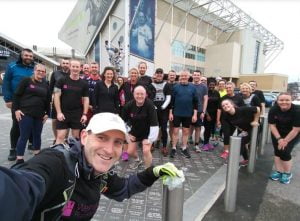Winter running top tips
As the dark nights draw in – going for a run might be quite low down on your list of priorities. We caught up with our run club leader Richard Warren to find out some top winter running tips for staying active this winter…
As the dark nights draw in – going for a run might be quite low down on your list of priorities. We caught up with our run club leader Richard Warren to find out some top winter running tips for staying active this winter…
Typically, the very first hurdle is what you see through the window when you wake up. We’ve been programmed to see wet/dark/cold and instantly turn to things that will protect us from it. It’s going to take some bravery at first, but a good tip is to dress in your running gear before you open your curtains as this sends you in the right direction of having made a decision, but also allows your body to begin to adapt to air contact, rather than the lethargic warmth of a dressing gown.

All blogs will tell you to layer up and it does help cut down draughts, but most clothing is pretty common sense; gloves, a couple of tops, jogging tights, tracksuit, hat/cap and jacket. However, there are a few tips to consider around those, which are influenced by my cycling groundings:
Visibility is often mooted and is down to personal experience to be honest (unless you’re a leader and need to be constantly seen). The obvious option is reflective strips on clothing or bands, but you can get running arm-band lights which do work well. Head torches are less about being seen, but really for seeing the ground and are clearly necessary for trails where you can frequently be caught in dark street patches.
Personal safety is key and as such by far the best approach is to join a running club, at least during winter. If this isn’t an option, then do take whatever safety precautions you can, such as pre-planning routes, telling someone, live position sharing through your favourite tracker (free live track on Garmin, premium on Strava) and emergency contacts.

Moving on to the physiological effects and remember we’re running through winter so that when spring arrives, we’re in a super-strong position. In fairness, advance-booking the odd running event to give yourself a reason to run through winter will add another motivational notch.
Let’s stress the importance of warmups and expect them to take longer plus, ease into running a little more gently, possibly by walking first – I always visualise muscles/tendons as plasticine; if stretched when cold, visible tears appear immediately but if you warm up and work it first, it can be stretched without tearing. Additionally, be aware that the body protects the core, therefore limbs may be de-prioritised for blood/water flow and take longer to warm up, plus may increase urine production.
There are statistics regarding nonlinear performance drop/effort required as temperatures approach and pass 0°C, so just be easy on yourself when checking performance and distance. The change in overall hydration and calorie burn due to the cold are quite complex and individualised, so just be aware that things may be different and gain the experience from your own body’s behaviour.
Post-run stretching is still an important facet – be mindful of how much quicker you will cool outdoors and the plasticine visualisation. Ideally, head indoors to continue stretching and potentially during a shower.
If you work at Wellington Place and would like to join the Wellington Pacers running club, then click here for more information.
Richard Warren is a corporate office convert – built an Agile IT career consulting to global financial market corporates before commencing an active lifestyle through commuting which progressed to run | ride | walk leading of large groups and huge charity/community voluntary time investment. Using England Athletics and British Cycling qualifications to provide innovative activities for positive active lifestyles towards climate and environmental benefit. https://runningseeds.co.uk/ | https://www.linkedin.com/in/richard-warren-wozzy/
Request a viewing
By filling in this form, you consent to your contact details being passed to our acting agents for the purposes of assisting with your enquiry.